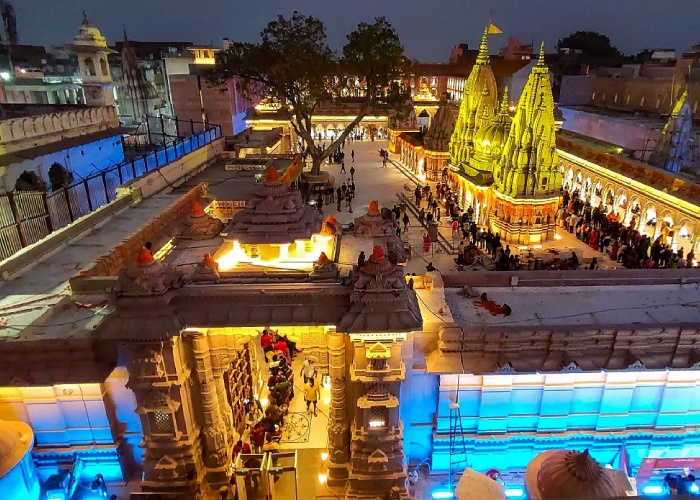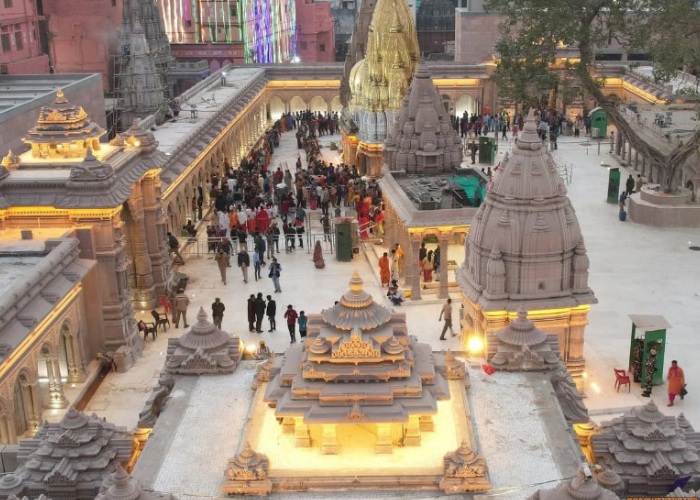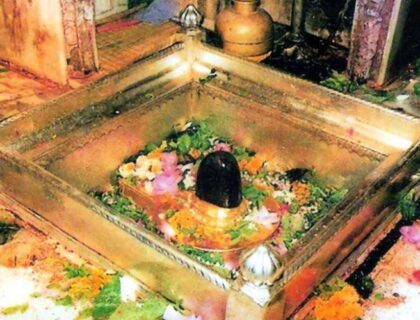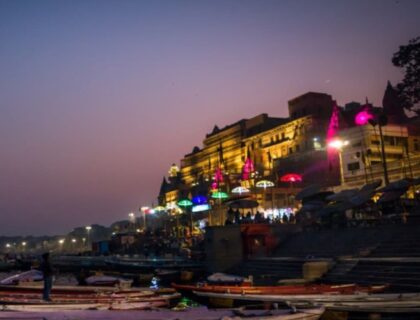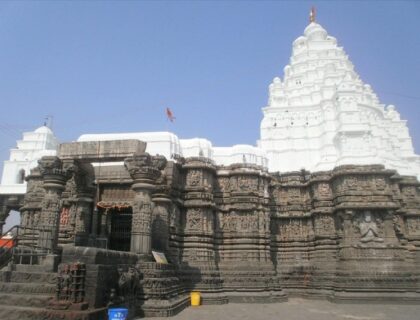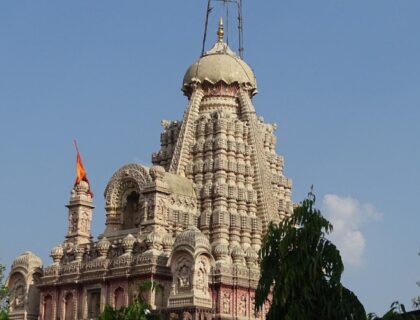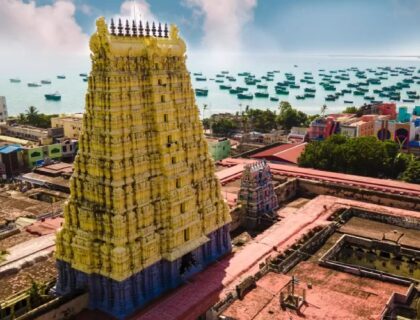Shree Kashi Vishwanath Jyotirling
Kashi Vishwanath Jyotirling Temple is a well-known Hindu shrine dedicated to Lord Shiva located in Vishwanath Gali in Varanasi City, Uttar Pradesh, India. The Kashi Vishvanath Jyotirling is one of the twelve Jyotirling temples, or holiest Shiva temples which is located on the western bank of the sacred River Ganga. The temple is denoted as Vishvanatha or Vishveshvara, which means “Ruler of the Universe,”.
Many people refer to the temple as Kashi Vishwanath Temple because Varanasi is also known as Kashi. According to Hindu scriptures, the temple is an important part of Shaiva worship. It was destroyed several times by Muslim Invaders, most recently by Aurangzeb, who built the Gyanvapi Mosque in the temple location site. The current structure was built on an adjacent site in 1780 by the Maratha ruler, Ahilyabai Holkar of Indore.
Story Behind Shree Kashi Vishwanath Jyotirling Temple
According to legend, Once Lord Brahma and Lord Vishnu fought over who was the most powerful. As a judge, Lord Shiva took the form of a light beam that passed through three worlds. Shiva instructed them to find the source of the light. The person who discovered the light’s tip would be regarded as the most powerful. Lord Brahma rode up on a horse to find the tip, while Vishnu disguised himself as a pig and dug it up.
Brahma falsely claimed to have discovered the pillar’s top. Vishnu, on the other hand, admitted modestly to his failure to locate the base. As a punishment, Shiva cut off Brahma’s fifth head and cursed him, declaring that he would no longer be worshipped. Because Vishnu was truthful, he would be worshipped alongside Shiva and have his own temples for the rest of time.

This temple is one of the 12 jyotirlinga temples, which are locations where Shiva’s light passed through the earth. A visit to this temple is a truly spiritual experience that no one should miss while in Varanasi.
History of Shree Kashi Vishwanath Jyotirling Temple
The original Vishwanath temple, initially known as the Adi Vishveshwara Temple, was destroyed by the Ghurids in 1194 When Mu’izz al-Din Muhammad ibn Sam arrived back in India, he defeated Jayachandra of Kannauj close to Chandawar and then destroyed the city of Kashi. In a few years, the Razia Mosque was constructed in the temple place. In 1230, the temple was rebuilt near the Avimukteshwara Temple, away from the main site by a Gujarati merchant during the reign of Delhi’s Sultan Iltutmish (1211–1266). It was demolished again during the rule of either Hussain Shah Sharqi (1447–1458) or Sikandar Lodi (1489–1517).
During Jahangir’s reign, Vir Singh Deo restored or completed the earlier temple. In 1669, Mughal emperor Aurangzeb demolished the temple and replaced it with the Gyanvapi Mosque. The foundation, columns, and back portion of the mosque still contain the remains of the previous temple.

In 1780, Malhar Rao’s daughter-in-law Ahilyabai Holkar rebuilt the present temple adjacent to the mosque. Prime Minister Narendra Modi started the Kashi Vishwanath Corridor Project in 2019 to make it easier to get to the temple from the Ganges River and create more spaces to avoid crowding. In a sacred ceremony on December 13, 2021, Narendra Modi inaugurated the corridor.
The puja of the Maa Shringar Gauri Temple, located on the western side of the disputed Gyanvapi Mosque, was restricted following the demolition of the Babri Masjid in December 1992 due to the ensuing deadly riots. Five Hindu women petitioned a local court in Varanasi in August 2021 to be allowed to pray at the Maa Shringar Gauri Temple.
According to a government press release, approximately 1,400 people and businesses in the corridor area were relocated and compensated. It also stated that more than 40 ancient temples, including the Gangeshwar Mahadev temple, Manokameshwar Mahadev temple, Jauvinayak temple, and Shri Kumbha Mahadev temple, were discovered and rebuilt.
Shree Kashi Vishwanath Jyotirling Temple Architecture
The temple complex consists of a series of smaller shrines located near the river in a small lane known as the Vishwanatha Galli. The main deity’s linga is 60 centimetres tall and 90 centimetres in circumference, and it is housed in a silver altar. The main temple is a quadrangle surrounded by shrines dedicated to other gods. The complex contains small temples dedicated to Kala Bhairava, Kartikeya, Avimukteshwara, Vishnu, Ganesha, Shani, Shiva, and Parvati.

Jnana Vapi, also known as Gyan vapi (the wisdom well), is a small well in the temple. The Jnana Vapi well is located to the north of the main temple, and during the Mughal invasion, the Jyotirlinga was hidden in the well to protect it. It is said that the temple’s main priest jumped into the well with the lingam to protect the Jyotirlinga from invaders.

There is a Sabha Griha or Congregation Hall that leads to the inner Garbha Griha or Sanctum Sanctorum. The honoured Jyotirlinga is a dark brown stone enshrined in the Sanctum and placed on a silver platform. The Mandir is divided into three sections. The first compromises the temple’s spire. The second structure is a gold dome, and the third is a gold spire atop the sanctum that bears a flag and a trident.
Important facts about Shree Kashi Vishwanath Jyotirling Temple
- Shree Kashi Vishwanath Jyotirling Temple is situated on the western bank of the Ganga River in Varanasi, Uttar Pradesh, India. Varanasi was formerly known as Kashi, so this temple is also known as the Kashi Vishwanath temple.
- The original Vishwanath temple, known as the Adi Vishveshwara Temple at the time, was destroyed by the Ghurids in 1194 when Mu’izz al-Din Muhammad ibn Sam returned to India and defeated Jayachandra of Kannauj near Chandawar before razing Kashi.
- It was rebuilt by various rulers, including Mughal emperor Akbar’s general, Raja Man Singh, and his finance minister, Raja Todar Mal.
- The current structure was built on an adjacent site in 1777 by Maratha ruler Rani Ahilya Bai Holkar of Indore.
- The Jyotirlinga is located in the sanctum, on a silver altar. Other gods with shrines include Vishnu, Vinayaka, Kalabhairav, and Saneeshwara.
- Inside the temple, there is a well-known As wisdom well or Gyan Wapi. When the Mughals came to destroy the temple, it is believed that the linga was hidden there.
- An unidentified donor from South India donated 60 kg of gold to the temple in February 2022, which was used to cover the sacred area in gold.
- In an effort to relieve overcrowding, Prime Minister Narendra Modi launched the Kashi Vishwanath Corridor Project in 2019.
- The temple now has four entrances for the convenience of devotees as a result of the project. The temple is located on the Ganga River’s western bank. The project includes 23 structures, including a museum, a viewing room, a food court, and a tourist information centre.
Famous Festivals In Kashi Vishwanath Jyotirling Temple
- Mahashivaratri: The Maha Shivaratri festival is a grand event at Kashi Vishwanath temple, as it is at all important Shiva temples. It is the main festival in town. Every year, millions of devotees flock to this town to catch a glimpse of the Lord on this auspicious day, which falls in February/March.
- Ganesh Chaturthi: Dedicated to Lord Ganesh, this festival is celebrated in August / September
- Durga Puja. (Winter) – Devotees celebrate Navaratri at this temple in the month of Ashwin (Sep-Oct) as well as celebrate the triumph of the Goddess Durga over the buffalo demon (Mahishasura).
- Navaratri. (Summer) – They celebrate other Navaratri in the fortnight of the Chaitra (March-April). Every nine days they worship Navadurga (nine Durgas).
Location & How to Reach Shree Kashi Vishwanath Jyotirling Temple
By Air: The nearest airport is Babatpur Airport which is 25 Km away from the Kashi Vishwanath Temple
By Railway: Kashi Vishwanath Temple is located almost 6 km away from the Varanasi railway station, 17 km away from Pd Din Dayal Upadhaya Junction (Mughal Sarai) and almost 6 km from the BHU.
By Roadways: The roads of Varanasi are easily connected to the other parts of the state. The temple can be reached easily by taxi or auto rickshaw after reaching the Varanasi Junction.
Also Read – Bhimashankar Jyotirling, Baidyanath Jyotirling
Location
Facilities
- Drinking Water
- Pooja Item Shops
- Prasad Shops
- Restaurants Nearby
- Resting Room



